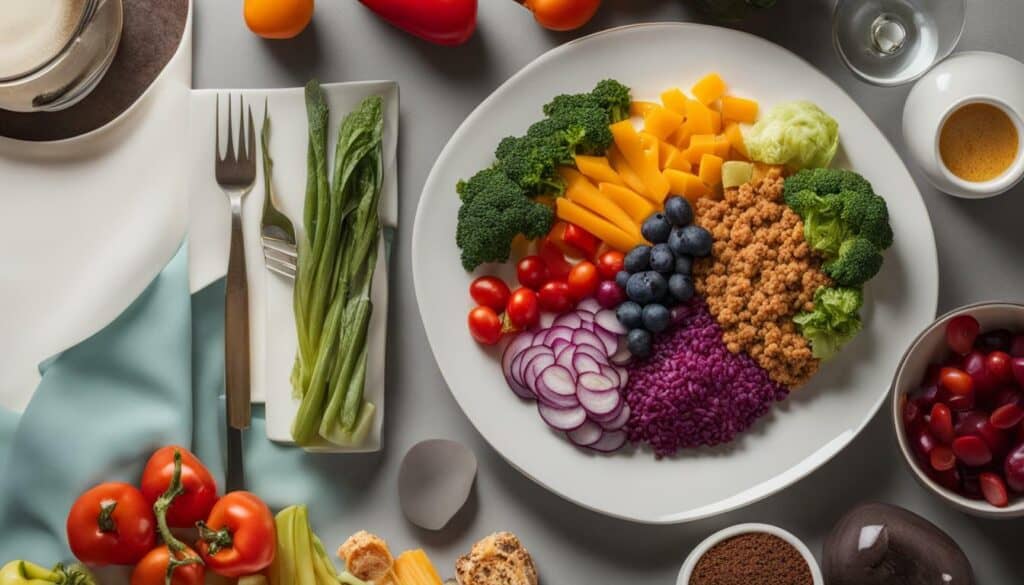Counting carbs is a crucial aspect of managing diabetes or following a low-carb diet, and understanding the carbs in cake is essential for making informed choices. Whether you have diabetes or are simply conscious of your carb intake, knowing the carb content of cake can help you maintain healthy blood sugar levels and achieve your weight loss goals.
Carb counting involves determining the number of grams of carbohydrates in a meal and matching it with the appropriate insulin dose or staying within a carb limit. You’ll find different methods of carb counting, from advanced techniques based on grams of carbohydrates to simpler approaches relying on carbohydrate choices.
Factors such as body size, activity level, and medical conditions influence the ideal number of carbs per meal. By personalizing your carb intake, you can ensure optimal health and blood sugar control.
Measuring tools, food labels, and online resources like the USDA Food Composition Database can help you accurately determine the carb content of different foods, including cake. Understanding the varying amounts of carbohydrates in non-starchy vegetables, fruits, whole grains, beans, and starchy vegetables is crucial for creating a well-balanced meal.
For those who prefer digital assistance, smartphone apps are available to help track carbs and support weight loss efforts and adherence to low-carb diets.
Key Takeaways:
- Counting carbs is crucial for managing diabetes and following a low-carb diet.
- Understanding the carb content of cake can help make informed dietary choices.
- Carb counting methods range from advanced techniques to simpler approaches.
- The ideal number of carbs per meal varies based on individual factors.
- Measuring tools, food labels, and online resources can assist in determining carb content.
The Basics of Carb Counting
Before we dive into the specific carb content of cake, let’s go over the fundamentals of carb counting and why it matters for your health. Counting carbs is essential for individuals with diabetes or those following a low-carb diet for weight loss. It involves determining the number of grams of carbohydrates in a meal and matching it with the appropriate insulin dose or to stay within a carb limit. By keeping track of your carb intake, you can better manage your blood sugar levels and ensure that you’re fueling your body with the right amount of energy.
There are different methods of carb counting that you can choose from. Some people prefer advanced carb counting, which involves calculating the exact number of grams of carbohydrates in a meal. This method provides precise control and is often used by those who require insulin therapy. On the other hand, simpler methods like carbohydrate choices focus on estimating the number of carbs based on predetermined serving sizes or portions. This can be a more flexible approach for those who don’t need precise calculations.
To determine the carb content of foods, including cake, you can use various resources. Measuring tools like food scales or cups can help you accurately measure the weight or volume of ingredients. Food labels provide valuable information about the nutritional content of packaged foods, including the total carbohydrates. You can also use online resources such as the USDA Food Composition Database to find the carb content of specific foods. These tools can assist you in making informed choices and tracking your carb intake effectively.
Understanding the basics of carb counting is crucial for managing your health and achieving your dietary goals. By becoming familiar with the carb content of foods, you can make informed decisions about what and how much to eat. In the next section, we’ll explore how to determine the carbohydrate content of cake and provide examples of popular cakes and their respective carb counts.

| Cake Type | Carbohydrate Content (per slice) |
|---|---|
| Chocolate Cake | 25g |
| Vanilla Cake | 30g |
| Red Velvet Cake | 40g |
Determining Carbohydrate Content
Accurately determining the carbohydrate content of cake is essential for effectively managing your carb intake, and there are various tools and resources available to assist you. Whether you’re counting carbs for diabetes management or following a low-carb diet for weight loss, understanding the carb content of cake can help you make informed choices and maintain control over your blood sugar levels.
One way to determine the carbohydrate content of cake is by using measuring tools. Measuring cups and kitchen scales can help you accurately measure the ingredients used in the cake recipe, allowing you to calculate the carb content more precisely. By knowing the exact amount of sugar, flour, and other carbohydrates in the cake, you can make adjustments to fit your dietary needs.
Another valuable resource for determining the carbohydrate content of cake is food labels. Many commercially-baked cakes come with nutrition labels that provide information about the serving size and the number of grams of carbohydrates per serving. Reading these labels can give you a good estimate of the cake’s carb content and help you stay within your carb limit.
If you’re looking for a more extensive database of cake carbohydrate values, online resources like the USDA Food Composition Database can be helpful. This comprehensive database provides detailed information about the nutritional composition of various foods, including cakes. By searching for the specific type of cake you’re interested in, you can find detailed information about its carbohydrate content and make more informed choices about your carb intake.
Table: Carbohydrate Content of Popular Cake Types
| Cake Type | Carbohydrate Content per Slice |
|---|---|
| Chocolate Cake | 30g |
| Vanilla Cake | 35g |
| Red Velvet Cake | 40g |
| Carrot Cake | 25g |

Insert the image
Carb counting can be approached in different ways, from more precise gram-based calculations to simplified methods based on carbohydrate choices. Let’s explore these methods to help you find the one that works best for you.
For individuals who prefer a more precise approach, advanced carb counting based on grams of carbohydrates is the way to go. This method involves carefully calculating the exact amount of carbohydrates in a meal and adjusting insulin doses accordingly. It requires the use of measuring tools, such as food scales or measuring cups, to accurately determine the carbohydrate content of each food item. Advanced carb counting is particularly useful for people with diabetes who need to match their insulin doses with their carb intake.
On the other hand, if you prefer a simpler method, you can opt for carbohydrate choices. This approach involves categorizing foods into predetermined carbohydrate choices and consuming a specific number of choices per meal. For example, a carbohydrate choice could be equivalent to 15 grams of carbohydrates. By keeping track of the number of carbohydrate choices consumed, you can effectively manage your carb intake without the need for precise calculations. This method is often recommended for individuals who do not require precise carb control or who find advanced carb counting too time-consuming.
To further assist you in understanding and implementing these carb counting methods, here’s a table summarizing their key aspects:
| Method | Approach | Advantages |
|---|---|---|
| Advanced Carb Counting | Precise gram-based calculations | Accurate insulin dosing, ideal for diabetes management |
| Carbohydrate Choices | Categorization of foods into predetermined choices | Simpler method, suitable for individuals not requiring precise carb control |
Remember, the best carb counting method for you depends on your specific needs and preferences. Whether you choose advanced carb counting or carbohydrate choices, both approaches can help you effectively manage your carbohydrate intake and support your health goals.
Personalizing Your Carb Intake
The right amount of carbs per meal can vary for each person, depending on individual factors like body size, activity level, and any specific medical conditions they may have. It’s essential to personalize your carb intake to meet your unique needs and maintain optimal health.
For individuals with diabetes, consulting with a healthcare professional or a registered dietitian is crucial in determining the ideal number of carbs per meal. These experts can help create a meal plan that considers your body’s insulin resistance, blood sugar goals, and any other relevant medical factors.
Activity level also plays a significant role in determining carb intake. If you’re physically active and engage in regular exercise, you may require more carbohydrates to fuel your workouts. On the other hand, those with a sedentary lifestyle may need to adjust their carb intake accordingly to avoid excess calorie consumption.
| Body size | Ideal Number of Carbs per Meal |
|---|---|
| Small | 30-45 grams |
| Medium | 45-60 grams |
| Large | 60-75 grams |
Remember, the table above is a general guideline and should be used as a starting point. It’s always best to consult with a healthcare professional or a registered dietitian to determine the most accurate and personalized carb intake for your specific needs.
By personalizing your carb intake based on factors like body size, activity level, and medical conditions, you can effectively manage your blood sugar levels, support weight loss efforts, and maintain overall health and well-being.

Balancing your carbohydrate intake involves incorporating a variety of food groups, including non-starchy vegetables, fruits, whole grains, beans, and starchy vegetables, in appropriate portions. These diverse food groups provide essential nutrients, vitamins, and minerals that contribute to a well-rounded and healthy diet.
Non-starchy vegetables, such as broccoli, spinach, and peppers, are low in carbohydrates and high in fiber, making them ideal choices for those looking to manage their carb intake. They add color and flavor to your plate while providing important vitamins and minerals. Fruits, like berries, apples, and oranges, are also rich in fiber and contain natural sugars. Enjoy them in moderation to satisfy your sweet tooth while keeping your overall carbohydrate consumption in check.
Whole grains, such as quinoa, brown rice, and whole wheat bread, are packed with fiber and complex carbohydrates. They provide sustained energy and contribute to feelings of fullness. Beans, like black beans, chickpeas, and lentils, are excellent sources of both carbohydrates and protein, making them a great addition to any balanced meal.
Starchy vegetables, including potatoes, corn, and peas, contain more carbohydrates than their non-starchy counterparts. However, they also offer important vitamins and minerals, so it’s best to enjoy them in moderation. Be mindful of portion sizes to maintain a balanced carb intake.

To help you visualize the appropriate portions of these food groups, here’s a handy table:
| Food Group | Examples | Suggested Portion Size |
|---|---|---|
| Non-starchy vegetables | Broccoli, spinach, peppers | 1 cup |
| Fruits | Berries, apples, oranges | 1 medium-sized fruit or 1/2 cup |
| Whole grains | Quinoa, brown rice, whole wheat bread | 1/2 cup cooked grains or 1 slice of bread |
| Beans | Black beans, chickpeas, lentils | 1/2 cup cooked beans |
| Starchy vegetables | Potatoes, corn, peas | 1/2 cup cooked vegetables |
By incorporating these food groups into your meals, you can strike a balance between satisfying your carbohydrate needs and maintaining a healthy eating plan. Remember, moderation is key, and listening to your body’s needs is essential for optimizing your overall well-being.
Tools for Tracking Carbs
Managing your carb intake becomes easier with the help of smartphone apps specifically designed to track your carbs and support your weight loss or low-carb diet journey. These apps allow you to effortlessly monitor your daily carbohydrate consumption, ensuring you stay within your desired limits and make informed choices about your food intake.
One popular app in this category is Carb Manager, which offers a comprehensive database of food items, including various types of cake, to help you accurately track their carbohydrate content. It allows you to log your meals, scan barcodes, and even create personalized recipes, simplifying the process of monitoring your carb intake. With Carb Manager, you can easily set your carb goals based on your individual needs and track your progress over time.
Another highly-rated option is MyFitnessPal, a versatile app that not only tracks carbs but also provides a holistic approach to managing your overall nutrition and fitness goals. With its vast food database and user-friendly interface, MyFitnessPal enables you to log your meals, track your macronutrients, and set specific targets for carb intake. The app also offers additional features like a built-in pedometer and the ability to sync with other fitness devices for a comprehensive overview of your health and wellness.
| App | Key Features | Price |
|---|---|---|
| Carb Manager | Comprehensive food database, barcode scanner, meal logging, recipe creation | Free with optional premium subscription |
| MyFitnessPal | Extensive food database, macronutrient tracking, holistic nutrition and fitness features | Free with optional premium subscription |
Using a carb tracking app can be a game-changer for individuals on weight loss or low-carb diets. It provides the convenience of on-the-go carb counting, ensuring you stay on track with your health goals. With just a few taps on your smartphone, you can have a clear overview of your carb consumption, making it easier to make informed decisions about your diet.
Whether you’re trying to shed pounds or manage your blood sugar levels, tracking your carbs is an essential part of your overall wellness journey. By incorporating these smartphone apps into your routine, you’ll gain valuable insights into your carbohydrate intake, empowering you to make healthier choices and achieve your desired outcomes.
Navigating Cake’s Carb Content
Now that we have a solid understanding of carb counting and its importance, let’s dive into the specifics of cake and uncover the range of carbohydrates you’ll find in various types of delicious cake creations. Whether you’re planning a special celebration or simply craving a sweet treat, it’s helpful to know how different cakes stack up in terms of carb content.
When it comes to the nutritional information of cakes, it’s important to note that the carb content can vary significantly depending on the type of cake and its ingredients. For example, a fluffy angel food cake is generally lower in carbs compared to a dense chocolate fudge cake. The addition of fruits, nuts, or fillings can also affect the overall carbohydrate count.
Here’s a breakdown of some popular cake varieties and their approximate carb counts per serving:
| Cake Type | Carb Content (per serving) |
|---|---|
| Angel Food Cake | 25 grams |
| Chocolate Fudge Cake | 50 grams |
| Vanilla Sponge Cake | 30 grams |
| Carrot Cake | 40 grams |
It’s important to keep in mind that these numbers are just approximate values, and the actual carb content may vary depending on the specific recipe and portion size. If you’re closely monitoring your carb intake, it’s always a good idea to consult the nutritional information provided on food labels or refer to reliable online resources for more accurate data.
By being aware of the carb content in various types of cake, you can make informed choices that align with your dietary goals and preferences. Remember, moderation is key, and enjoying a slice of cake can still be a part of a balanced eating plan. So go ahead, indulge in your favorite cake, and savor every delicious bite!
| Cake Type | Carb Content (per serving) |
|---|---|
| Angel Food Cake | 25 grams |
| Chocolate Fudge Cake | 50 grams |
| Vanilla Sponge Cake | 30 grams |
| Carrot Cake | 40 grams |
*The values provided are approximate and may vary based on specific recipes and portion sizes. Consult food labels and online resources for more accurate information.

Conclusion
Understanding the carbs in cake is a valuable asset on your healthy eating journey, and armed with this knowledge, you can make informed decisions to support your overall well-being. Counting carbs is especially important for individuals with diabetes or those following a low-carb diet for weight loss. By accurately determining the number of grams of carbohydrates in a meal and matching it with the appropriate insulin dose or adhering to a carb limit, you can effectively manage your blood sugar levels and achieve your health goals.
There are different methods of carb counting, ranging from advanced techniques based on grams of carbohydrates to simpler methods based on carbohydrate choices. The ideal number of carbs per meal varies based on individual factors such as body size, activity level, and medical conditions. It’s essential to personalize your carb intake to ensure optimal health and blood sugar control.
When determining the carb content of foods like cake, it’s helpful to use measuring tools, refer to food labels, or utilize online resources like the USDA Food Composition Database. These tools can assist you in accurately calculating the carbohydrate content of different cakes, empowering you to make informed choices about your carbohydrate intake.
Remember that while cake may be delicious, it’s important to maintain a balanced approach to carb consumption. Non-starchy vegetables, fruits, whole grains, beans, and starchy vegetables all contain varying amounts of carbohydrates and should be included in moderate portions for a well-rounded meal. By incorporating these food groups into your diet, you can enjoy a variety of flavors while maintaining a healthy carb balance.
For those who wish to track their carbs and other factors relevant to their health goals, there are smartphone apps available that can assist in this process. These tools provide a convenient way to monitor your carb intake, support weight loss efforts, and adhere to low-carb diets.
In conclusion, understanding the carbs in cake is crucial for maintaining a healthy lifestyle. By being aware of the carbohydrate content of cake and other foods, you can make informed decisions about your diet and achieve your health and wellness goals. So, the next time you indulge in a slice of cake, you can do so with knowledge and confidence, knowing that you are making choices that support your overall well-being.
FAQ
Q: Why is counting carbs important for individuals with diabetes or those following a low-carb diet?
A: Counting carbs helps individuals with diabetes manage their blood sugar levels and allows those following a low-carb diet to stay within their desired carb limit for weight loss.
Q: What is carb counting?
A: Carb counting involves determining the number of grams of carbohydrates in a meal and matching it with the appropriate insulin dose or staying within a carb limit.
Q: What are the different methods of carb counting?
A: Different methods of carb counting include advanced carb counting based on grams of carbohydrates and simpler methods based on carbohydrate choices.
Q: How can I determine the carbohydrate content of different foods?
A: Measuring tools, food labels, and online resources like the USDA Food Composition Database can help determine the carb content of different foods.
Q: How many carbs should I have per meal?
A: The ideal number of carbs per meal varies based on individual factors like body size, activity level, and medical conditions.
Q: Which foods should I include in my diet for a balanced carb intake?
A: Non-starchy vegetables, fruits, whole grains, beans, and starchy vegetables should be included in moderate portions for a well-balanced meal.
Q: Are there any tools or apps that can help me track my carb intake?
A: Yes, there are smartphone apps available that can help track carbs and other factors to support weight loss and low-carb diets.
Is Cake Included in the Handy Food List for Managing Carbs?
Yes, cake can be a part of a carb-friendly food list if chosen wisely. Opting for healthier cake options like those made with whole grains, reduced sugar, or alternative sweeteners can be a smart choice. However, it is essential to enjoy cake in moderation and balance it with other nutrient-dense foods to manage carb intake effectively.





Leave a Reply